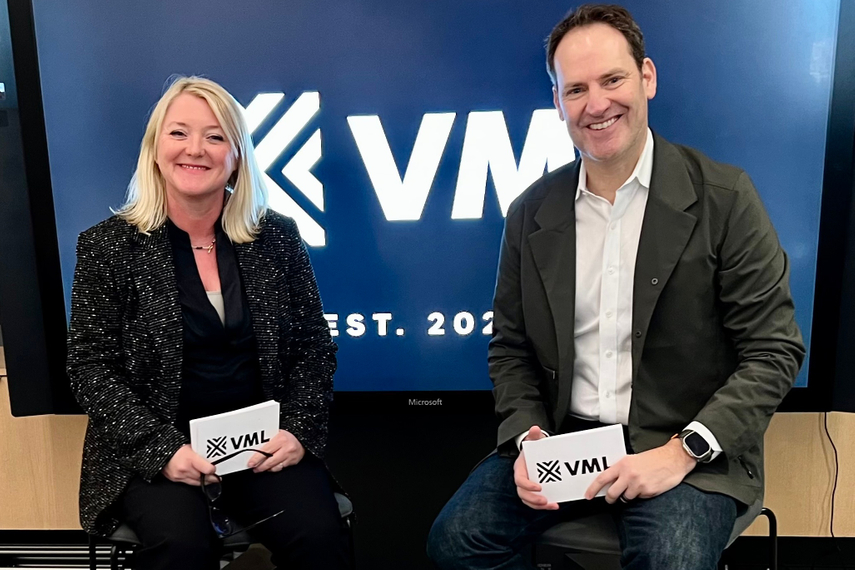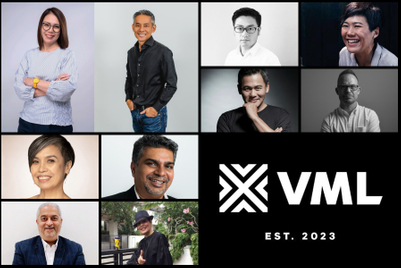
As the leaders of VML, soon to be the world’s largest creative agency, travel the globe to speak to employees and clients about WPP’s latest internal mega-merger, CEO Jon Cook and president Mel Edwards hope they can benefit from some of the hard work that has already been done by their teams.
At a recent town hall in Singapore, Cook, who is American, and Edwards, who is British, found themselves speaking less and instead sharing the microphone with VMLY&R and Wunderman Thompson employees from across the Asia-Pacific region who were already collaborating on multiple projects.
“Do we even need to be here?” Edwards later mused, “Because I feel like this is done.”
Naturally, she was jesting. The merger of their two agencies, which was announced in October and takes effect from January, is far from done.
Cook and Edwards -- who sat down with Campaign twice over the course of the last month, in Singapore and London respectively -- say they are only beginning to tackle the hard details around systems integrations and where they can find the cost savings and efficiencies that WPP CEO Mark Read expects, particularly after the holding company’s worse-than-expected third-quarter earnings.
The two agency leaders both have experience of previous internal mergers at WPP and they say communication is easier than in 2018, when Cook led the merger of VML with Y&R and Edwards did the same with Wunderman and JWT.
She says she learnt from the earlier merger that “you've got to get in front of people quicker” to explain the rationale and drive momentum. Technology has helped, with all employees now connected through Zoom or Teams thanks to the pandemic.
Cook and Edwards say the hard work done through those previous mergers to instil a more collaborative working culture has made this go-around feel a bit less daunting.
Lost legacy?
It’s for this reason that Cook bristles at critics who argue WPP is impulsively killing three of its most storied and prestigious advertising agency brands and diminishing the creative reputation those agencies painstakingly built over decades. J Walter Thompson was founded in 1864, Young & Rubicam in 1923 and Wunderman in 1958.
“It’s frustrating when [the news] boils down to a headline that reads like some robotic spreadsheet action, but that disregards the idea that leaders like Mel and myself are in these positions because of how much we care about these brands,” Cook argues.
“I think there’s a little naivete to the idea that these four companies - VML, Y&R, Wunderman and J. Walter Thompson - were all operating as those brands before. It’s almost forgotten that we’ve already transformed those brands into new companies in the last five years and that they all had different trajectories five or six years ago,” Cook adds, alluding to the pre-merger struggles of JWT and Y&R for survival in the digital age.
From Cook's perspective, the storied agencies and the people within them were adapted and evolved, if not rescued, for changing times.
“I get people feel sensitive about the name and the brands,” Edwards says. “There’s amazing heritage, but it’s what we do with that heritage to make VML the company it needs to be moving forward [that counts],” she adds, pointing to how initiatives like the Helen Lansdowne Resor Scholarships, honouring J. Walter Thompson’s first female copywriter will be integrated into the new VML.

Cook believes VML’s relative youth – John Valentine, Scott McCormick, and Crag Ligibel founded the agency in 1992 – is an asset as they look to start a new chapter. Hence why the branding for VML says “established 2023”.
The rationale for clients
Meanwhile, the notion that clients themselves have deep attachment to a particular agency brand doesn’t hold water for Edwards. “We haven’t lost a client because of an agency name,” she points out. “It’s about the people that sit behind those brands.”
Easily the top concern among clients so far, the leaders say, is whether their agency teams will change. And for the most part, that answer is “no”, say the chiefs.
VML may introduce new people to their clients as more capabilities are introduced, Cook says, but there’s no plan to break up teams.
Conflicts with competitors, another typical concern brands have in such mergers, are surprisingly few. In fact, 17 of their top 20 clients including Coca-Cola, Nestle, Dell and Microsoft already work with both agencies.
The merger will make it easier for clients who want a joined-up approach from their agency partner. Accessing VML’s range of capabilites will be simpler, with fewer “access points”, according to Cook.
And scale matters as WPP finds itself competing with consulting giants such as Accenture in the pursuit of big clients. VML will have both “consultant-level scale” and the “creativity that they [the consultants] are killing for”, he maintains.
Geographical compatibility
Client overlap is not the only area where there appears to be a business rationale for the merger. The two agencies have some geographic compatibility.
VML is stronger in the United States, its home market, whereas Wunderman Thompson has a greater presence in Europe and Asia-Pacific. “That’s fair,” Cook says. “I wouldn't say that anybody's weak in a particular region but, absolutely, the reputations differ from place to place.”
VML has already made a number of key leadership appointments, including global chief creative officer Debbi Vandeven and global chief client officer Eric Campbell – both from VMLY&R.
By contrast, the regional chief executives for EMEA, Ewen Sturgeon, and LATAM, Juan Pablo Jurado, hail from Wunderman Thompson. APAC will have co-CEOs, Audrey Kuah and Yi-Chung Tay, from Wunderman Thompson and VMLY&R respectively.
Individual market chiefs are set to be announced shortly. Earlier WPP consolidations have made decisions easy in some markets like Vietnam, where Wunderman Thompson has been rolled into VMLY&R already.
But harder choices are also coming. In cases where there are two strong leaders from the two agencies, Edwards says they plan to ensure there are roles for both, though some will be better placed in a new role, Cook adds.
In the UK, Pip Hulbert, CEO of Wunderman Thompson, has landed the CEO job at VML. Meanwhile, Michelle Whelan, the co-chief executive of VMLY&R London and chief executive of VMLY&R Commerce, will become UK chief client officer and Justin Pahl, the other co-CEO of VMLY&R London, will step into a new role of global client lead at WPP.
Where people are placed will depend partly on where their skill sets match with the new VML “trilogy” of core practices in brand experience (BX), customer experience (CX) and commerce.
It’s in commerce where the leaders say their agency capabilities are the most complementary, with only a five to ten percent overlap in function between VMLY&R’s front-end customer-facing commerce services and Wunderman Thompson’s commerce platform work, to create a complete end-to-end commerce experience.
In BX and CX, the two agencies provide quite similar services, which means their focus will largely be on integrating services, forming a common language and providing scale. With the possibility of duplication, these areas look ripe for savings.
In his initial comments to analysts about the merger, Cook noted there were no job cuts planned. Speaking with Campaign, he reiterates that headcount should remain “similar” to its combined agency size of 30,000 people globally though there will be areas where it will make sense to create efficiencies. Nor do they plan to exit any of the 64 markets they’re currently in.
“We don’t have less to do,” Cook says.
Cost savings: real estate and back-end systems
While Cook and Edwards have also been tasked with finding millions of dollars in cost savings from the merger, their work here is just beginning and they declined to comment on any specific areas they’re targeting, aside from a few obvious pieces of low-hanging fruit.
One area singled out is back-end systems. The two agencies use different enterprise resource planning (ERP) systems and currently perform daily tasks, such as filing time sheets, differently, necessitating varied levels of oversight and approvals. “That’s going to be a huge area of efficiency,” Cook says.
The admission that two of WPP’s largest integrated creative agencies have been using different ERP systems is surprising, given the parent company has been looking to simplify operations for at least five years – indeed it was part of the rationale for the earlier VMLY&R and Wunderman Thompson mergers.
When Campaign asked Read at its Q3 results if the holding company had been slow to simplify and standardise business operations, he rejected the suggestion and pointed the finger at his predecessor, Sir Martin Sorrell, for “30 years of inactivity on that topic.”
A second key savings target for VML is real estate as Cook and Edwards plan for a significant consolidation of office space.
In London, Wunderman Thompson will move to join VML in WPP’s Sea Containers House HQ (at one point, the two agencies previously shared office space in the same building, Greater London House, in Mornington Crescent, which is Wunderman Thompson’s current home).
In New York, the two agencies will most likely occupy one and a half floors of the WPP campus as opposed to three currently, while in Singapore the agencies’ third and fourth floor spaces at WPP’s Scotts Road building will likely be vacated to bring everyone in VML down to the ground floor.
While there will be changes to how teams work, and some more than others, Edwards stresses that in creating the new agency’s operating models, great pains have been taken to ensure that not one former agency brand dominates over another. “It feels really balanced,” she enthuses.
Perhaps for the same reason, Cook insists that the agency will not be headquartered in a single location. Most of the global leadership are spread fairly equally across Kansas City, the original home of VML, where he is based, New York and London, he says.
“We are a creative company”
The merger of VML comes at a challenging time for creative networks in most of the big holdcos, not just WPP. They have faced structural pressures since before the pandemic as some clients have switched from retained accounts to project work and set up in-house agencies, and the rise of generative artificial intelligence poses a new threat.
After a post-pandemic bounceback, things have got tougher again. Cook and Edwards talk about the growth of their respective agencies in the last five years, but revenues at WPP’s integrated creative agencies fell 0.9% in the first nine months of 2023.
The negative narrative raises questions about VML’s positioning. Is it even a creative agency when its focus is not only on advertising and brand experience but also customer experience and commerce? Or does the concept of a creative agency need to be broadened?
Cook is in no doubt: “The concept needs to be broadened.” He says it is “frustrating” that some in the industry continue to think of creative as “something that sits over here and then you've got your commerce and your CRM [that sit somewhere else].”
VML is “defining creativity” as brand experience, customer experience and commerce. “That’s our proposition – and it works,” he says. “Creativity runs through all of them. Not creative equals advertising [alone]. That's a frustrating label.”
Edwards says they did debate whether to describe the new agency as “a creative consultancy” or another similar term but dismissed that idea. “At the end of the day, we are a creative company.”
VML’s new chiefs have made the case for the merger but now they must execute and deliver. Cook admits: “That's for us to prove out.”



.jpg&h=334&w=500&q=100&v=20250320&c=1)

+(900+x+600+px)+(3).png&h=334&w=500&q=100&v=20250320&c=1)




.jpg&h=334&w=500&q=100&v=20250320&c=1)







.jpg&h=268&w=401&q=100&v=20250320&c=1)
.jpg&h=268&w=401&q=100&v=20250320&c=1)